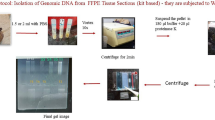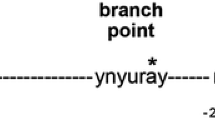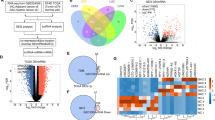Abstract
Objective: To identify the relation between nasopharyngeal carcinoma and the human novel gene UBAP1, which is located in the region of minimal heterozygosity deletion at 9pl3.2 and down-expressed in NPC. Methods: Five single nucleotide polymorphisms (SNPs) within UBAP1 gene were analysed by sequencing in 105 NPC patients and 183 control subjects which matched to the NPC cases on age, sex and residence. Results: Significant association was found between NPC with one SNP mark (rslO49557), which is located at 3′ non-region of UBAP1 gene; the relative risk of this SNP mark is 1.64 (genotype GG) and 1.31 (genotype CG). Conclusion: The result has proved again that UBAP1 gene may play a certain role in the occurrence and development of nasopharyngeal carcinoma. The SNP mark rslO49557, considering its location, may influence the expression of UBAP1 gene.
Similar content being viewed by others
References
Parkin DM, Laara E, Muir CS. Estimates of the worldwide frequency of sixteen major cancers in 1980 [J]. IntJ Cancer 1988; 41:184.
Hildesheim A, Levine PH. Etiology of nasopharyngeal carcinoma: a review [J]. Epidemiol Rev 1993; 15:466.
Qian J, Yang JB, Zhang XH, et al. Isolation and characterization of a novel cDNA, UBAP1, derived from the tumor suppressor locus in human chromosome 9p21–22 [J]. Cancer Res Clin Oncol 2001; 127:613.
Qian J, Tang K, Cao Li, et al. In silico expression analysis of human novel gene UBAP1 in multiple cancers [J]. Chin J Cancer Res 2002; 14:157.
Brookes AJ. The essence of SNPs [J]. Gene 1999; 234:177.
Sambrook J, Russell DW Molecular cloning: a laboratory manual, 3rd ed [M]. New York: Cold spring harbor laboratory press, 2001; 6.4
Ewing B, Hillier L, Wendl MC, et al. Base-calling of automated sequencer traces using Phred. I. Accuracy assessment [J]. Genome Res 1998; 8:175.
Ewing B, Green P. Base-calling of automated sequencer traces using Phred. II. Error probabilities [J]. Genome Res 1998; 8:186.
Nickerson DA, Tobe VO, Taylor SL. PolyPhred: automating the detection and genotyping of single nucleotide substitutions using fluorescence-based resequencing [J]. Nucleic Acids Res 1997; 25:2745.
Gordon D, Abajian C, Green P. Consed: a graphical tool for sequence finishing [J]. Genome Res 1998; 8:195.
Dixon WJ, Massey FJ. Introduction to statistical analysis [M]. New York: McGraw-Hill Inc., 1983; 101.
Cargill M, Altshuler D, Ireland J, et al. Characterization of single-nucleotide polymorphisms in coding regions of human genes [J]. Nat genet 1999; 22:231.
Huang DP, Lo KW, van Hasselt CA, et al. A region of homozygous deletion on chromosome 9p21–22 in primary nasopharyngeal carcinoma [J]. Cancer Res 1994; 54:4003.
Chen YJ, Ko JY, Chen PJ, et al. Chromosomal aberrations in nasopharyngeal carcinoma analyzed by comparative genomic hybridization [J]. Genes Chromosomes Cancer 1999; 25:169.
Hui AB, Lo KW, Leung SF, et al. Detection of recurrent chromosomal gains and losses in primary nasopharyngeal carcinoma by comparative genomic hybridization [J]. Int J Cancer 1999; 82:498.
Mutirangura A, Tanunyutthawongese C, Pornthanakasem W, et al. Genomic alterations in nasopharyngeal carcinoma: loss of heterozygosity and Epstein-Bar virus infection [J]. Br J Cancer 1997; 76:770.
Lo KW, Huang DP, Lau KM. pl6 gene alteration in nasopharyngeal carcinoma [J]. Cancer Res 1995; 55: 2039.
Sun Y, Hildesheim A, Lanier AE, et al. No point mutation but decreased expression of the pl6/MSTl tumor suppressor gene in nasopharyngeal carcinomas [J]. Oncogene 1995; 10:785.
Waber P, Dlugosz S, Cheng QC, et al. Genetic alteration of chromosome band 9p21–22 in head and neck cancer are not restricted to pl6 INK4a [J]. Oncogene 1997; 15: 1699.
Wiest JS, Franklin WA, Otstot JT, et al. Identification of a novel region of homozygous deletion on chromosome 9p in squamous cell carcinoma of the lung: the location of a putative tumor suppressor gene [J]. Cancer Res 1997; 57:1.
Coleman A, Fountain JW, Nobori T, et al. Distinct deletion of chromosome 9p associated with melanoma versus glioma, lung cancer, and leukemia [J]. Cancer Res 1994; 54:344.
Kamb A, Gruis NA, Weaver-Feldhaus J, et al. A cell cycle regulator potentially involved in genesis of many tumor types [J]. Science 1994; 264:436.
Yang JB, Tang XN, Deng LW et al. Detailed deletion mapping of chromosome 9p21–22 in nasopharyngeal carcinoma [J] (in Chinese). Chin J Oncol 1999; 21:419.
Watterson GA, Guess HA. Is the most frequent allele the oldest [J]. Theor Popul Biol 1977; 11:141.
Author information
Authors and Affiliations
Corresponding author
Additional information
Foundation item: This work was supported by a grant from the National “863” High-Tech Program of China (No. 2001AA221031) and a grant from the National Natural Science Foundation of China (No.30100027).
Biography: ZENG Zhao-yang (1974-), female, bachelor of medicine, assistant professor, Xiangya School of Medicine, Central South University, majors in oncology.
Rights and permissions
About this article
Cite this article
Zeng, Zy., Xiong, W., Xiong, F. et al. Case-control association studies of the UBAP1 gene and nasopharyngeal carcinoma in southern Chinese. Chin J Cancer Res 15, 157–160 (2003). https://doi.org/10.1007/s11670-003-0018-y
Received:
Accepted:
Issue Date:
DOI: https://doi.org/10.1007/s11670-003-0018-y




